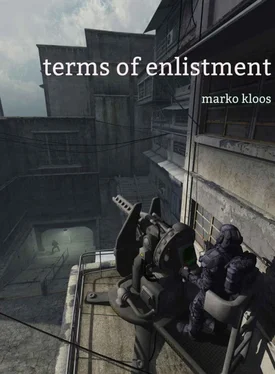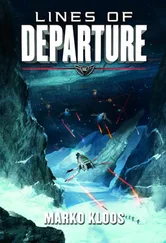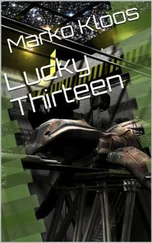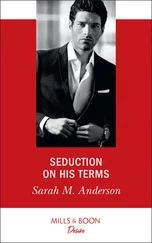The smoke grenades explode with a muffled pop, covering the area in front of us in thick, white smoke. The sniper is undeterred. He fires again, and the bullet strikes one of the windows behind us with a slap. Finally, someone gets a computer fix on the most likely trajectory of the sniper’s rounds. The TacLink updates everyone’s displays, superimposing a faint target caret over the sniper’s suspected position a few hundred yards down the street, and the two squads around me open up with their rifles.
“Grayson, with me. Sergeant Ellis, mind the shop for a minute. Grayson and I are going to carry the Ell-Tee back to the square and get him onto the bird. The rest of you, cover our asses.”
“Affirmative,” Sergeant Ellis replies. He’s the squad leader of Third Squad, and nominally equal in seniority to Sergeant Fallon at this point, but our squad leader is so high in the company’s pecking order that any NCO lower than the company sergeant usually defers to her.
The lieutenant is out cold. The bullet has torn the partially raised visor from his helmet, and then nailed him in the forehead at an angle. His face is covered in blood, and his forehead looks like someone’s given him a glancing blow with an axe, but he’s still breathing, and the round doesn’t seem to have penetrated the bone. Sergeant Fallon removes his helmet, drops it on the ground next to her, and then holds out her hand.
“Give me a trauma pack, Grayson.”
I reach into the side pocket of my ICU pants and pull out a bandage packet. I pull open the plastic seal, shake out the bandage, and hand it to Sergeant Fallon. She places it on the lieutenant’s forehead. The thermal bandage instantly adheres to his wound, sealing the gash in his head.
“He’ll live to collect his Purple Heart,” Sergeant Fallon pronounces. “Help me get him over to the ship.”
We each grab one of Lieutenant Weaving’s arms to haul up his bulk, which is considerable. He’s a tall guy, a hundred and ninety pounds at least, and the battle armor weighs another thirty pounds on top of that.
“Grab his rifle, too,” the sergeant says. I stoop down to pick up the lieutenant’s M-66. I notice that he still has four full magazine pouches, and my computer informs me that his rifle is still loaded with 250 rounds.
“Valkyrie Six-One, ETA one minute,” I hear over the platoon channel. “Keep your heads low down there.”
We head to the main entrance of the building at an awkward short-step run, with Lieutenant Weaving’s inert mass hanging between us. There are still rioters all over the place, but they’re mostly busy avoiding us, now that we’ve demonstrated that we’re willing to use our live rounds.
Overhead, I hear the engines of the descending drop ship. They’re coming in at high speed, a combat landing with emphasis. As we turn the corner to the main civic plaza, I flinch at the sight of more bodies on the ground, easily twice as many as there are in front of First Squad’s position. Second Squad didn’t hold back.
“Bravo One-One, this is Bravo One-Two. We have three casualties that need to go out on your ship.”
“Copy that, Bravo One-Two. Bring ‘em up, and don’t dawdle,” Sergeant Fallon responds.
The drop ship makes a dramatic entry. It breaks out of the low clouds, banked in a tight final turn. For a moment, a primal fear grips me at the sight of that huge, lethal-looking war machine. Whoever designed the Hornet drop ship didn’t spend a moment considering aesthetics. It’s all angles and facets, bristling with multi-barreled cannons and ordnance pods. It looks like someone’s fever-induced idea of a cross between a hornet and a dragonfly, blown up to massive size and clad in laminate armor.
As I watch, the landing gear of the drop ship extends, and the ship slows down for a vertical touchdown. At the last moment, the pilot turns the Hornet to make the tail and loading ramp face the administration building, and the weapons arrays point in the direction of the threat. I can see the cannon in the nose turret swinging side to side as the gun system automatically scans for targets. Then the main gear touches down, and the Hornet settles in a low crouch. The cargo ramp at the rear opens with a hydraulic whine.
“There’s your ride,” Sergeant Fallon tells the unconscious Lieutenant Weaving.
We carry the lieutenant into the plaza. The tail of the drop ship is a few dozen yards from the building. The crew chief steps out onto the ramp formed by the lower half of the cargo door, and waves us on.
We’re thirty feet from the ramp when the thunder of heavy automatic weapons fire rolls across the plaza. I look around for a threat, thinking that the chin turret of the drop ship is engaging a target. Then I see that the tracers are coming in rather than going out.
“Hit the deck,” Sergeant Fallon shouts, and we do, taking Lieutenant Weaving down to the ground with us.
Ahead of us, there’s a noise like hail on a metal roof as the drop ship starts taking hits.
“Where the fuck is that coming from?” someone shouts over the platoon channel.
“The rooftops,” someone else replies. “They got guns on the rooftops, right and center.”
Ahead of us, the drop ship pilot gooses the engines and picks the ship off the ground. The crew chief in the hatch holds on for balance, and then retreats back into his armored ship. I wonder why the chin turret isn’t firing back. The streams of tracers come from the rooftops of two tenement buildings, one on the right side of the plaza, and one at the far side, directly opposite the civic building. Both buildings are standard welfare shoebox stacks, thirty floors high, and I realize that the gun turret of the drop ship can’t deflect that high.
The guns on the rooftops fire in bursts, maybe twenty rounds at a time. Sergeant Fallon and I are in the open, between the relative safety of the building, and that of the armored ship. The hatch of the drop ship is much closer than the concrete overhang of the civic building, but the drop ship is already three feet off the ground, and it doesn’t look like the crew feels like waiting around while their ship is getting sprayed with incoming fire.
“Where the fuck did these people get heavy machine guns?” Sergeant Fallon asks. She pulls a smoke grenade out of her harness and motions for me to do the same. We chuck our grenades out into the plaza, and a few moments later, our position is obscured in thick smoke.
“Let’s get the hell out of here,” Sergeant Fallon suggests. We seize the still unconscious lieutenant by the arms once more and start our dash back to the building. Behind us, the machine gun rounds keep hitting the armor of the drop ship in a steady staccato.
Suddenly, the pitch of the engines changes, and I can hear right away that something essential just broke. The steady howl of the turbines turns into a tortured shriek. I look over my shoulder and see smoke pouring out of the starboard engine. Another stream of tracers comes down onto the drop ship, which is now fifty feet above the plaza. As they impact the armor, they throw up red and yellow sparks, the tell-tale signature of armor-piercing rounds hitting a hard surface.
“Don’t stop to sight-see, moron,” Sergeant Fallon yells. We finish our dash to the safety of the overhang in front of the building.
Some of the troopers from Second Squad are crouching at the edge of the overhang. They’re aiming their rifles skyward, firing bursts at the source of the tracer rounds raking our drop ship. Whoever set up those machine guns knows the capabilities of a Hornet. The ship is most vulnerable sitting on the ground, and the machine guns are high up on rooftops, out of reach of the Hornet’s chin turret and its rapid-fire cannon. The position of the guns is either incredibly fortuitous, or shrewdly planned. I set down the lieutenant, sling his rifle across my chest armor, and then check the loading status of my own weapon. The grenades in my harness are all non-lethal munitions, nothing that could do more than irritate the enemy machine gun crews. In any case, there’s nothing in my assortment of launcher munitions that can reach all the way up to the roof of a thirty-story building.
Читать дальше












